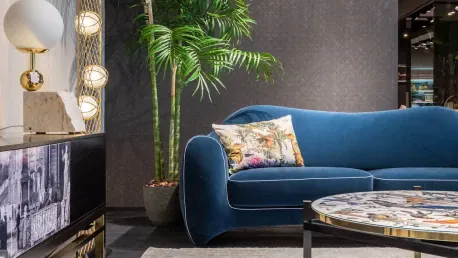The resurgence of patterned sofas in the world of interior design is making waves in 2025. With the cozy maximalism trend growing and a renewed appreciation for traditional themes, patterned sofas are gaining traction as chic focal points in living spaces. But is this trend a wise investment for homeowners?
The Rise of Patterned Sofas
Cozy Maximalism and Traditional Elements
Patterned sofas are central to the cozy maximalism trend, which emphasizes vibrancy and personality over minimalism. This marks a significant shift in interior design preferences as homeowners are more inclined to embrace bold, statement-making pieces that reflect individual tastes. The coziness of maximalism, which marries large-scale patterns and plush textures, is redefining how living spaces are styled, veering away from the cold minimalism that has been prevalent in recent years. Trends are leaning toward creating warm, welcoming environments filled with character, where every piece of furniture tells a story.
Alongside cozy maximalism, there’s a renewed appreciation for traditional elements. Classic patterns such as damasks, florals, and geometric designs are making a comeback, adding layers of nostalgia and comfort to modern interiors. These patterns not only evoke a sense of timeless style but also integrate beautifully with the eclectic mix of contemporary and vintage items, which characterize cozy maximalism. The emphasis is on creating harmonious spaces that are as much a visual feast as they are a comforting retreat.
Moving Beyond Neutrals
Design experts observe a noticeable move away from neutral or safe choices. The preference for patterned sofas and other vibrant furniture pieces is a departure from the understated elegance that has dominated for years. This shift influences the overall ambiance of living spaces, infusing them with a dynamic and lively energy that plain tones rarely achieve. Bold patterns and vivid colors are seen as expressions of personality and creativity, making a statement about the homeowner’s unique tastes and preferences.
Patterned sofas have emerged as a key player in this context, offering an alternative to the ubiquitous gray, beige, and white palettes. Their exciting patterns can bridge diverse decor elements, tying various colors and textures together in a cohesive manner. This move toward vibrancy is not merely aesthetic; it’s about embracing a fuller spectrum of life experiences and memories, making living spaces genuinely reflective of those who inhabit them.
Expert Opinions
Visual Interest and Expression
Experts agree that patterned sofas add visual interest and depth to a room, making it a centerpiece around which other design elements revolve. They enable homeowners to express their personalities and bring unique aesthetics to their interiors. An intricately patterned sofa can draw the eye and create a focal point, establishing a central theme for the room. This element of visual intrigue encourages creativity and personalization, allowing for greater experimentation with decor. A space that incorporates a patterned sofa often feels more engaging and personalized, facilitating a deeper connection between the space and its residents.
Moreover, the versatility in patterns—from intricate designs to bold, simple prints—allows for a broad range of expression. A patterned sofa can convey whimsy, elegance, or modernity, depending on the design. This adaptability ensures that no matter the homeowner’s style, there’s a patterned sofa that can complement and enhance their vision, turning a simple piece of furniture into a statement of individuality.
Versatility in Design
Patterned sofas offer versatility, easily blending with various design aesthetics. Whether the choice leans towards large-scale florals for a feminine touch or small geometric prints for a mid-century modern vibe, these sofas can adapt to multiple styles. The adaptability of patterned sofas means they can comfortably inhabit both a contemporary urban loft and a cozy countryside home. This chameleon-like quality makes them a smart choice for those who enjoy periodically refreshing their interiors, as the sofa can fit into multiple redecorating cycles without feeling out of place.
Designers note that a well-chosen pattern can harmonize disparate decor elements, pulling together a room’s look in a sophisticated manner. Patterns can be used strategically to either soften sharp lines and modern edges or to add complexity to simpler, more traditional interiors. This ability to blend into, yet enhance, a plethora of styles makes the investment in a patterned sofa a forward-thinking decision. Additionally, the wide array of available patterns ensures that there is something for every taste, making the patterned sofa a timeless piece rather than a fleeting trend.
Practicality and Functionality
Anchoring Large Spaces
In larger living spaces, a patterned sofa can serve as an anchor, providing a grounded visual balance. This is particularly useful in open-plan areas where distinct zones need to be defined without walls. The boldness of patterns helps delineate spaces, giving rooms structure and purpose. For instance, a patterned sofa in a vast open space can naturally create a defined living area, making the environment feel more intimate and cohesive. This effect allows for a versatile use of space, enabling functional zoning within a large room without the need for physical dividers or barriers.
Moreover, in grand spaces that can sometimes feel empty or impersonal, a patterned sofa adds warmth and a lived-in feel. It contributes to an inviting atmosphere, softening the sometimes overwhelming expansiveness of large rooms. The patterns themselves can evoke certain emotions or vibes, further contributing to the room’s overall ambiance and making it feel like a curated space rather than a mere expanse of square footage.
Wear and Tear
Patterned sofas are practical for hiding wear and tear, making them ideal for homes with children or pets. The patterns can camouflage stains and dirt, a feature that enhances their long-term usability. This practicality is a significant benefit for active households where the stress of maintaining pristine furniture can be challenging. With patterned upholstery, small marks and inevitable signs of use blend into the design, reducing the need for frequent cleaning or replacement.
Additionally, patterned fabrics can be selected for their durability, ensuring they withstand everyday use without compromising on style. This combination of aesthetics and functionality makes patterned sofas a practical choice for various lifestyles. Families with young children or multiple pets will find that patterns help maintain a clean look for longer periods, extending the lifespan of the sofa and adding value to the initial investment.
Potential Drawbacks
Challenging to Redecorate
One of the significant drawbacks is the difficulty in changing decor styles. Unlike smaller decorative items, a patterned sofa represents a considerable commitment. Homeowners may find themselves locked into a specific aesthetic that could feel outdated over time. This risk is particularly pertinent for those who enjoy regularly updating their interiors or tend to follow fleeting trends. The bold nature of patterns means that if tastes change, finding a harmonious way to integrate the existing patterned sofa into a new decor scheme can be cumbersome.
Furthermore, swapping out a large piece like a sofa incurs greater expense and effort than rotating smaller accents, meaning that committing to a patterned sofa is a decision that requires foresight. Choosing a pattern that has timeless appeal or can adapt to minor shifts in interior trends helps mitigate this challenge, but it remains a consideration for those who prioritize flexibility in their home decor.
Balancing Decor Elements
Pairing patterned sofas with other decor elements requires careful consideration. These sofas can easily lead to a visually busy space if not balanced properly. Maintaining harmony in room design can become challenging, necessitating thoughtful placement of complementary items. Successful integration of a patterned sofa involves balancing it with solid colors, neutral tones, and subtle textures within the same space. This ensures the room is cohesive without becoming overwhelming.
Designers often suggest a simplified approach to surrounding decor when incorporating a patterned sofa, utilizing it as a statement piece while keeping other elements understated. This method allows the sofa to shine without clashing with other vibrant patterns or colors. Failure to manage this balance can result in a cluttered, discordant space, reducing the appeal of the patterned sofa and the room as a whole.
Conclusion
In 2025, there’s a notable resurgence of patterned sofas in interior design, capturing significant attention. Amid the growing cozy maximalism trend and a renewed appreciation for traditional themes, these stylish sofas are increasingly becoming the centerpiece of living rooms. Homeowners looking for distinctive and chic elements to enhance their space find patterned sofas particularly appealing.
This shift marks a departure from the neutral and minimalistic furniture trends that have dominated interiors in recent years. The bold designs and vibrant patterns of these sofas add a layer of complexity and visual interest that plain, solid-colored pieces simply can’t offer. They’re not just comfortable but also serve as conversation starters, drawing eyes and compliments alike.
However, the question remains: Is investing in a patterned sofa a wise decision for homeowners? On one hand, these pieces can significantly refresh and modernize a space, making it uniquely yours. On the other hand, they might not be as timeless as more conventional, neutral pieces, possibly clashing with future design changes or trends.
Ultimately, investing in a patterned sofa depends on your personal style and long-term design vision. If you’re inclined toward creating a bold, lively environment filled with personality, a patterned sofa could be an excellent choice. Conversely, if flexibility and timelessness are your priorities, opting for something more understated might be wiser.









